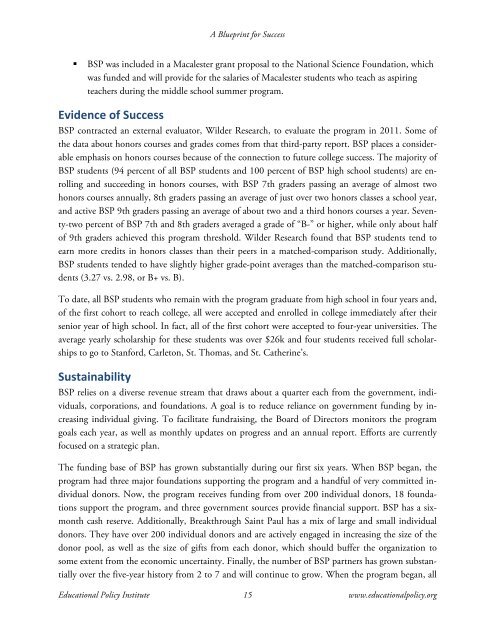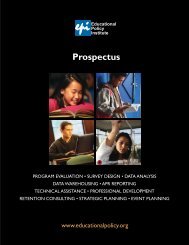A BluePrint for Success: Case Studies of Successful - Educational ...
A BluePrint for Success: Case Studies of Successful - Educational ...
A BluePrint for Success: Case Studies of Successful - Educational ...
You also want an ePaper? Increase the reach of your titles
YUMPU automatically turns print PDFs into web optimized ePapers that Google loves.
A Blueprint <strong>for</strong> <strong>Success</strong><br />
BSP was included in a Macalester grant proposal to the National Science Foundation, which<br />
was funded and will provide <strong>for</strong> the salaries <strong>of</strong> Macalester students who teach as aspiring<br />
teachers during the middle school summer program.<br />
Evidence <strong>of</strong> <strong>Success</strong><br />
BSP contracted an external evaluator, Wilder Research, to evaluate the program in 2011. Some <strong>of</strong><br />
the data about honors courses and grades comes from that third-party report. BSP places a considerable<br />
emphasis on honors courses because <strong>of</strong> the connection to future college success. The majority <strong>of</strong><br />
BSP students (94 percent <strong>of</strong> all BSP students and 100 percent <strong>of</strong> BSP high school students) are enrolling<br />
and succeeding in honors courses, with BSP 7th graders passing an average <strong>of</strong> almost two<br />
honors courses annually, 8th graders passing an average <strong>of</strong> just over two honors classes a school year,<br />
and active BSP 9th graders passing an average <strong>of</strong> about two and a third honors courses a year. Seventy-two<br />
percent <strong>of</strong> BSP 7th and 8th graders averaged a grade <strong>of</strong> “B-” or higher, while only about half<br />
<strong>of</strong> 9th graders achieved this program threshold. Wilder Research found that BSP students tend to<br />
earn more credits in honors classes than their peers in a matched-comparison study. Additionally,<br />
BSP students tended to have slightly higher grade-point averages than the matched-comparison students<br />
(3.27 vs. 2.98, or B+ vs. B).<br />
To date, all BSP students who remain with the program graduate from high school in four years and,<br />
<strong>of</strong> the first cohort to reach college, all were accepted and enrolled in college immediately after their<br />
senior year <strong>of</strong> high school. In fact, all <strong>of</strong> the first cohort were accepted to four-year universities. The<br />
average yearly scholarship <strong>for</strong> these students was over $26k and four students received full scholarships<br />
to go to Stan<strong>for</strong>d, Carleton, St. Thomas, and St. Catherine’s.<br />
Sustainability<br />
BSP relies on a diverse revenue stream that draws about a quarter each from the government, individuals,<br />
corporations, and foundations. A goal is to reduce reliance on government funding by increasing<br />
individual giving. To facilitate fundraising, the Board <strong>of</strong> Directors monitors the program<br />
goals each year, as well as monthly updates on progress and an annual report. Ef<strong>for</strong>ts are currently<br />
focused on a strategic plan.<br />
The funding base <strong>of</strong> BSP has grown substantially during our first six years. When BSP began, the<br />
program had three major foundations supporting the program and a handful <strong>of</strong> very committed individual<br />
donors. Now, the program receives funding from over 200 individual donors, 18 foundations<br />
support the program, and three government sources provide financial support. BSP has a sixmonth<br />
cash reserve. Additionally, Breakthrough Saint Paul has a mix <strong>of</strong> large and small individual<br />
donors. They have over 200 individual donors and are actively engaged in increasing the size <strong>of</strong> the<br />
donor pool, as well as the size <strong>of</strong> gifts from each donor, which should buffer the organization to<br />
some extent from the economic uncertainty. Finally, the number <strong>of</strong> BSP partners has grown substantially<br />
over the five-year history from 2 to 7 and will continue to grow. When the program began, all<br />
<strong>Educational</strong> Policy Institute 15 www.educationalpolicy.org




